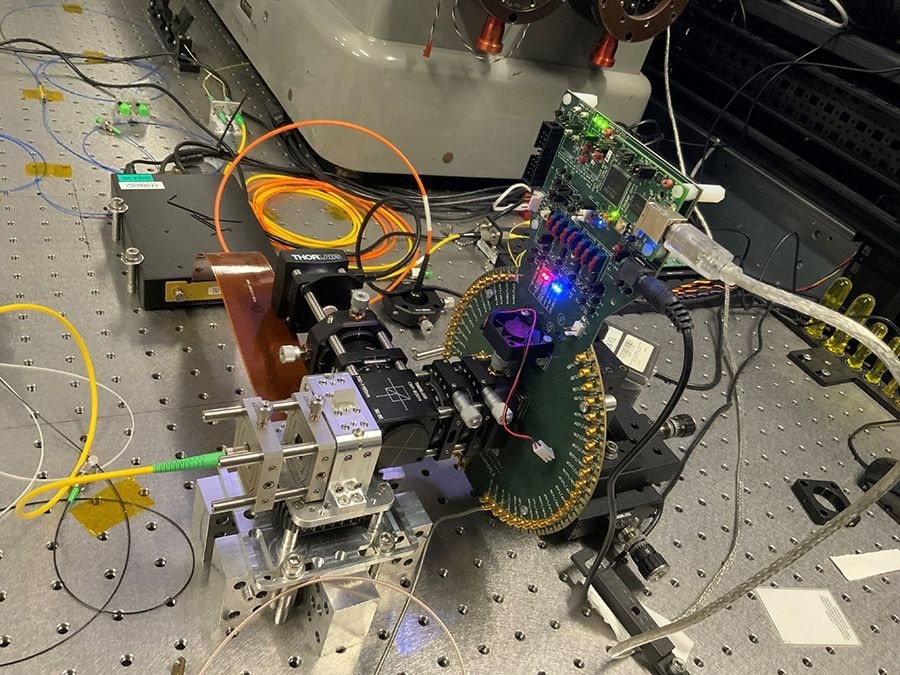Lasers have become a significant part of everyday life. The applications this technology offers are so extensive even the scientists who handle lasers on a daily basis are constantly astonished. Among them is University of Queensland Research Fellow Dr Martin Plöschner from the School of Information Technology and Electrical Engineering (ITEE).

The laser tool developed by the UQ team. Image Credit: Dr. Martin Plöschner
I’ve been working with lasers for the past 15 years and yet I’m often surprised to find them in the most unexpected places. In many of their applications, lasers operate in part of the spectrum which is invisible to our eyes. And what the eyes can’t see, the mind often doesn’t know about. If lasers operated more in the visible part of the spectrum, the world around us would be a magnificent laser show.
Dr Martin Plöschner, Research Fellow, School of Information Technology and Electrical Engineering, University of Queensland
One such unfamiliar laser application is optical data communication, where laser light travels via optical fibers to supply information.
However, the constantly growing demand for faster and more repeated access to information is pushing optical fiber networks worldwide to their maximum boundary—the so-called “capacity crunch.”
Dr. Joel Carpenter from UQ’s ITEE explained the laser light pulses transmitted along the plastic or glass fibers move at various speeds and can overlap, decelerating the process.
Imagine yelling to a friend through a long concrete pipe. Your message will distort depending on how much the pipe echoes, and you’ll also have to wait for the echoes to die down from one message before you can send the next. It’s a similar problem in large groups of computer servers, with the amount of echo dependent on the shape and color of the lasers being launched into the optical fiber.
Dr Joel Carpenter, School of Information Technology and Electrical Engineering, University of Queensland
It is vital to measure the properties of lasers in order to make enhancements, but there has been no technique to completely exploit this complexity—until this current research.
Having wide knowledge of laser beam manipulation, shaping, and characterization, Dr. Carpenter, Dr. Plöschner, and their team were eager to solve the issue.
They linked up with one of the top laser manufacturers, II-VI Inc., and worked for three years on a method to increase the speed of lasers and enhance their functionality.
They created a tool that ascertains the output of vertical-cavity surface-emitting lasers (VCSELs) and enables the analysis of the large volumes of data their light transmits.
The system itself is about the size of a shoebox and is simply inserted into the path of the laser beam. It can tell us how the laser beam evolves in time and changes its shape and color.“That information is crucial to how the beam travels through the fiber link.
Dr. Martin Plöschner, Research Fellow, School of Information Technology and Electrical Engineering, University of Queensland
The results can currently be applied to develop the next generation of lasers.
“Our tool will make it possible to identify the beam features that contribute to ‘pulse spreading’ in the optical link, which slows down data,” Dr Plöschner said.
“Laser engineers can then design lasers without these rogue features, leading to optical links with higher speed and longer distance of operation.”
“And any tool that can facilitate faster data transfer over longer distances is helpful.”
Dr. Plöschner stated that enhanced laser technology is set to transform a variety of industries, ranging from telecommunications to car manufacturing and security.
Autonomous cars use lasers to make a 3D image of the scene to help them navigate through traffic or reverse park in a tight spot. And you’re scanned by hundreds of tiny lasers every time you use facial recognition to unlock your smartphone.“It comes as no surprise then that there’s a huge demand to make lasers with improved performance.“This breakthrough will unlock an information treasure trove of optical beams.
Dr. Martin Plöschner, Research Fellow, School of Information Technology and Electrical Engineering, University of Queensland
Journal Reference
Plöschner, M., et al. (2022) Spatial tomography of light resolved in time, spectrum, and polarisation. Nature Communications. doi.org/10.1038/s41467-022-31814-2.